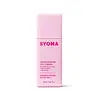What's inside
What's inside
 Key Ingredients
Key Ingredients

 Benefits
Benefits

 Concerns
Concerns

 Ingredients Side-by-side
Ingredients Side-by-side

Water
Skin ConditioningGlycerin
HumectantBehenyl Alcohol
EmollientCoco-Caprylate/Caprate
EmollientGlyceryl Stearate
EmollientDimethicone
EmollientPanthenyl Triacetate
Ethyl Linoleate
EmollientTrehalose
HumectantLinoleic Acid
CleansingLinolenic Acid
CleansingOleic Acid
EmollientCeramide Ns
Skin ConditioningPhospholipids
Skin ConditioningMethyl Cyclodextrin
7-Dehydrocholesterol
Emulsion StabilisingGlycolipids
Skin ConditioningGlycine Soja Sterols
EmollientPerilla Frutescens Leaf Extract
MaskingAlpha-Glucan Oligosaccharide
CleansingPolymnia Sonchifolia Root Juice
Skin ConditioningTocopherol
AntioxidantPropanediol
SolventOrnithine
Skin ConditioningSaccharomyces Ferment Lysate Filtrate
Skin ConditioningCholesterol
EmollientLactobacillus
Skin ConditioningPalmitic Acid
EmollientStearic Acid
CleansingLecithin
EmollientInulin Lauryl Carbamate
Emulsion StabilisingHydrogenated Lecithin
EmulsifyingBenzyl Alcohol
PerfumingCarbomer
Emulsion StabilisingSodium Dehydroacetate
PreservativeLauryl Alcohol
EmollientLevulinic Acid
PerfumingP-Anisic Acid
MaskingSodium Hydroxide
BufferingMyristyl Alcohol
EmollientCetyl Alcohol
EmollientOleyl Alcohol
EmollientDehydroacetic Acid
PreservativeOctyldodecanol
EmollientMaltodextrin
AbsorbentCitric Acid
BufferingSodium Benzoate
MaskingPotassium Sorbate
PreservativeWater, Glycerin, Behenyl Alcohol, Coco-Caprylate/Caprate, Glyceryl Stearate, Dimethicone, Panthenyl Triacetate, Ethyl Linoleate, Trehalose, Linoleic Acid, Linolenic Acid, Oleic Acid, Ceramide Ns, Phospholipids, Methyl Cyclodextrin, 7-Dehydrocholesterol, Glycolipids, Glycine Soja Sterols, Perilla Frutescens Leaf Extract, Alpha-Glucan Oligosaccharide, Polymnia Sonchifolia Root Juice, Tocopherol, Propanediol, Ornithine, Saccharomyces Ferment Lysate Filtrate, Cholesterol, Lactobacillus, Palmitic Acid, Stearic Acid, Lecithin, Inulin Lauryl Carbamate, Hydrogenated Lecithin, Benzyl Alcohol, Carbomer, Sodium Dehydroacetate, Lauryl Alcohol, Levulinic Acid, P-Anisic Acid, Sodium Hydroxide, Myristyl Alcohol, Cetyl Alcohol, Oleyl Alcohol, Dehydroacetic Acid, Octyldodecanol, Maltodextrin, Citric Acid, Sodium Benzoate, Potassium Sorbate
Water
Skin ConditioningGlycerin
HumectantCaprylic/Capric Triglyceride
MaskingPentaerythrityl Tetraethylhexanoate
EmollientNiacinamide
SmoothingCeramide NP
Skin ConditioningCholesterol
EmollientPhytosphingosine
Skin ConditioningPolyglyceryl-3 Methylglucose Distearate
EmulsifyingStearic Acid
CleansingOleic Acid
EmollientLactic Acid
BufferingTromethamine
BufferingCamellia Sinensis Leaf Extract
AntimicrobialHydroxyacetophenone
AntioxidantCetearyl Alcohol
EmollientCarbomer
Emulsion StabilisingXanthan Gum
Emulsifying1,2-Hexanediol
Skin ConditioningWater, Glycerin, Caprylic/Capric Triglyceride, Pentaerythrityl Tetraethylhexanoate, Niacinamide, Ceramide NP, Cholesterol, Phytosphingosine, Polyglyceryl-3 Methylglucose Distearate, Stearic Acid, Oleic Acid, Lactic Acid, Tromethamine, Camellia Sinensis Leaf Extract, Hydroxyacetophenone, Cetearyl Alcohol, Carbomer, Xanthan Gum, 1,2-Hexanediol
 Reviews
Reviews

Ingredients Explained
These ingredients are found in both products.
Ingredients higher up in an ingredient list are typically present in a larger amount.
Carbomer is a polymer of acrylic acid. Its main role is to create a gel consistency.
A high amount of carbomer can cause pilling or balling up of products. Don't worry, most products contain 1% or less of carbomer.
Cholesterol is a class of organic molecules called lipids. It helps hydrate your skin and is essential to having a healthy skin barrier.
Our skin naturally contains cholesterol in the outermost layer. Besides cholesterol, it also contains ceramides and fatty acids. Cholesterol makes up about 1/4 of your skin's outer layer and barrier. Your skin barrier is responsible for keeping allergens and microbes out. Having a healthy skin barrier is also responsible for keeping your skin firm and plump.
Our bodies use cholestrol to create vitamin D, steroid hormones, and more.
Learn more about CholesterolGlycerin is already naturally found in your skin. It helps moisturize and protect your skin.
A study from 2016 found glycerin to be more effective as a humectant than AHAs and hyaluronic acid.
As a humectant, it helps the skin stay hydrated by pulling moisture to your skin. The low molecular weight of glycerin allows it to pull moisture into the deeper layers of your skin.
Hydrated skin improves your skin barrier; Your skin barrier helps protect against irritants and bacteria.
Glycerin has also been found to have antimicrobial and antiviral properties. Due to these properties, glycerin is often used in wound and burn treatments.
In cosmetics, glycerin is usually derived from plants such as soybean or palm. However, it can also be sourced from animals, such as tallow or animal fat.
This ingredient is organic, colorless, odorless, and non-toxic.
Glycerin is the name for this ingredient in American English. British English uses Glycerol/Glycerine.
Learn more about GlycerinOleic Acid is an Omega-9 fatty acid. It can be found in many plant oils such as avocado and marula oils.
This ingredient is used to enhance the texture of products and as a cleansing agent.
Oleic Acid may not be fungal acne safe.
Learn more about Oleic AcidStearic Acid is a fatty acid. It is an emollient, emulsifier, and texture enhancer.
As an emollient, stearic acid helps soften skin. It aids the skin's protective barrier by preventing water loss. It also provides a gentle cleansing effect without stripping away natural oils.
Stearic acid may also be used to enhance the texture of products. It can add volume and stabilize ingredients such as water and oil. This can help water and oil ingredients from separating.
Sources of stearic acid include animal or vegetable fats/oils such as coconut or shea. It can be naturally found in butter, cocoa butter, shea butter, vegetable fats, and animal tallow.
This ingredient may not be Malassezia folliculitis, or fungal-acne safe.
Learn more about Stearic AcidWater. It's the most common cosmetic ingredient of all. You'll usually see it at the top of ingredient lists, meaning that it makes up the largest part of the product.
So why is it so popular? Water most often acts as a solvent - this means that it helps dissolve other ingredients into the formulation.
You'll also recognize water as that liquid we all need to stay alive. If you see this, drink a glass of water. Stay hydrated!
Learn more about Water